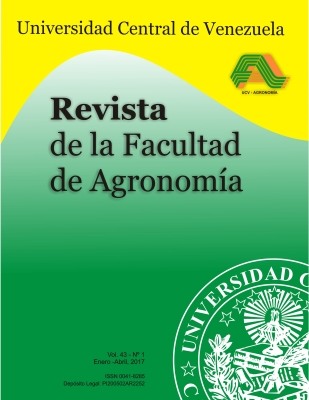Mohos toxigénicos asociados a semillas de caraota (Phaseolus vulgaris L.) comercializados en Maracay, estado Aragua, Venezuela
Palabras clave:
Fabáceas, granos, hongos, micotoxinas, grains, fungi, incidenceResumen
La caraota (Phaseolus vulgaris L.) es uno de los cultivos de mayor importancia para el continente americano; considerándose un recurso alimenticio de gran valor nutricional, de bajo costo y accesible a todos los estratos socioeconómicos de la población. Sin embargo, los granos de caraota son colonizados por mohos, los cuales alteran las fracciones nutritivas, y algunos sintetizan metabolitos tóxicos, denominados micotoxinas. Estas son carcinogénicas, mutagénicas y teratogénicas, y afectan a la salud pública y animal. El objetivo de esta investigación fue detectar y cuantificar la incidencia de mohos toxigénicos asociados a granos de P. vulgaris. Se analizaron 27 muestras de granos de caraota blanca, roja y negra (dos marcas comerciales y una a granel) comercializados en la ciudad de Maracay, estado Aragua. Se utilizó un diseño de bloques al azar, con tres repeticiones por muestras y tres muestreos, conformando nueve tratamientos. Se detectaron y se cuantificaron los mohos, utilizando el método de siembra directa de 100 granos enteros, previamente desinfectados con NaClO 1,5% por 30s. Se sembraron de 12-13 granos/placa en la superficie del medio malta sal agar (pH 5,8). Después de ocho días de incubación (±24-26 °C) se cuantificaron los mohos totales y por especies. Se identificaron nueve especies fúngicas referidas a los géneros Aspergillus, Penicillium y Eurotium. Los mohos de mayor incidencia (>30%) fueron: Penicillium citrinum y Eurotium amstelodami, y de baja incidencia (<15%) Aspergillus niger, Aspergillus flavus, Aspergillus candidus, Aspergillus versicolor, Aspergillus terreus, Aspergillus oryzae y Aspergillus ochraceus. La presencia de especies fúngicas toxigénicas en los granos evaluados representan un riesgo potencial para la salud pública y animal, por la posible contaminación con micotoxinas.
ABSTRACT
Caraota (Phaseolus vulgaris L.) is one of the most important crops for the American continent; considered a nutritional resource of great nutritional value, low cost and accessible to all socioeconomic strata of the population. However, the beans are colonized by molds, which alter the nutritive fractions and some synthesize toxic metabolites called mycotoxins. The mycotoxins are carcinogenic, mutagenic and teratogenic, and affect public and animal health. The objective of this investigation was to detect and quantify the incidence of toxigenicmolds associated with P. vulgaris beans. Twenty seven samples of white, red and black beans (two commercial brands and one in bulk) marketed in the city of Maracay, Aragua state, were analyzed. A randomized block
design was used, with three repetitions per sample and three samples, forming nine treatments. The molds were detected and quantified, using the direct sowing method of 100 whole grains, previously disinfected with 1.5% NaClO for 30s. Twelve-thirteen grains / plates were seeded on the surface of the medium malt agar salt (pH 5.8). After eight days of incubation (± 24-26 °C) the total molds and the species were quantified. Nine fungal species related to the genera Aspergillus, Penicillium and Eurotium were identified. The molds with the highest incidence (>30%) were: Penicillium citrinum and Eurotium amstelodami, and of low incidence (<15%) Aspergillus niger, Aspergillus flavus, Aspergillus candidus, Aspergillus versicolor, Aspergillus terreus, Aspergillus oryzae and Aspergillus ochraceus. The presence of toxigenic fungal species in the grains evaluated represents a potential risk for public and animal health, due to the possible contamination with mycotoxins.





